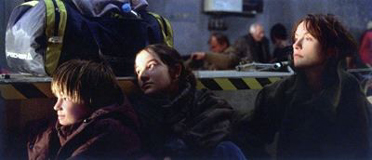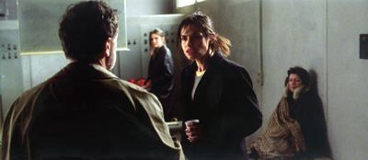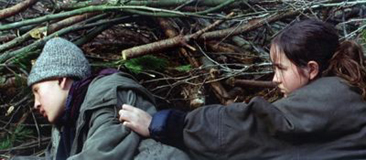The Time of the Wolf (Michael Haneke, 2003)
 Michael Hanekeís The
Time of the Wolf starts with a series of shots of a family minivan that
deliberately recalls the opening of his Funny
Games. Perhaps appropriately, then, the first few minutes of the film play
like that film in fast-forward before the movie shifts off into a different
direction, which is both more harrowing and humane than the confrontational Funny
Games. Definitely less provocative than Hanekeís usual output, The
Time of the Wolf shows us a point of view that seems to disarm criticisms
that his previous films were sadistically programmed to shock the audience
solely for the sake of shocking them. Despite all the doom and gloom, thereís
a sliver of hope present here that would almost qualify this as the happy Haneke.
By the standard of any major director, outside of Bergman, a film as
relentlessly bleak as The Time of the Wolf would qualify as some sort of apotheosis of
misery. For Haneke, itís almost a reprieve from his usual uncompromising
nature. Not coincidentally, the movie Wolf
most readily begs comparison to is Bergmanís superior Shame,
a work that similarly observes a society so stressed that itís essentially
nonexistent.
Michael Hanekeís The
Time of the Wolf starts with a series of shots of a family minivan that
deliberately recalls the opening of his Funny
Games. Perhaps appropriately, then, the first few minutes of the film play
like that film in fast-forward before the movie shifts off into a different
direction, which is both more harrowing and humane than the confrontational Funny
Games. Definitely less provocative than Hanekeís usual output, The
Time of the Wolf shows us a point of view that seems to disarm criticisms
that his previous films were sadistically programmed to shock the audience
solely for the sake of shocking them. Despite all the doom and gloom, thereís
a sliver of hope present here that would almost qualify this as the happy Haneke.
By the standard of any major director, outside of Bergman, a film as
relentlessly bleak as The Time of the Wolf would qualify as some sort of apotheosis of
misery. For Haneke, itís almost a reprieve from his usual uncompromising
nature. Not coincidentally, the movie Wolf
most readily begs comparison to is Bergmanís superior Shame,
a work that similarly observes a society so stressed that itís essentially
nonexistent.
 Before settling down somewhat, The Time of the Wolf offers a harrowing and formally accomplished
glance into the animalistic abyss that is mankind without order or compassion.
Centering on Anna (Isabelle Huppert), a mother whoís desperately trying to
hold her family together, the first act of the film reduces its characters to a
nearly primitive state. It instills in the audience, through a masterful use of
screen space and scale, a primal fear of the dark. Marked by a procession of
burning cows and eerily misty fields, the gargantuan landscapes of the
countryside suddenly become an imposing force. With all of the comforts of
society gone, nature suddenly must be reckoned with. We watch as these
characters realize that elemental forces like fire and darkness once again
warrant fear. When Anna stands in the complete darkness and spies a light in the
distance, itís at once a reprieve from the unremitting night and terrifying
because it means that another person is out there with her. At one point, a boy
makes a grave for a pet from rocks and logs. As crude a gesture as it is, it
provides a reassuring moment, because itís the most civilized action on
display. In the next scene though, Anna stumbles in the dark and knocks the
grave over, giving the impression that even that last vestige of society has
crumbled. Itís a masterful moment in a virtuoso sequence that would likely
lose most of its impact if not projected in the blackness of a theater.
Before settling down somewhat, The Time of the Wolf offers a harrowing and formally accomplished
glance into the animalistic abyss that is mankind without order or compassion.
Centering on Anna (Isabelle Huppert), a mother whoís desperately trying to
hold her family together, the first act of the film reduces its characters to a
nearly primitive state. It instills in the audience, through a masterful use of
screen space and scale, a primal fear of the dark. Marked by a procession of
burning cows and eerily misty fields, the gargantuan landscapes of the
countryside suddenly become an imposing force. With all of the comforts of
society gone, nature suddenly must be reckoned with. We watch as these
characters realize that elemental forces like fire and darkness once again
warrant fear. When Anna stands in the complete darkness and spies a light in the
distance, itís at once a reprieve from the unremitting night and terrifying
because it means that another person is out there with her. At one point, a boy
makes a grave for a pet from rocks and logs. As crude a gesture as it is, it
provides a reassuring moment, because itís the most civilized action on
display. In the next scene though, Anna stumbles in the dark and knocks the
grave over, giving the impression that even that last vestige of society has
crumbled. Itís a masterful moment in a virtuoso sequence that would likely
lose most of its impact if not projected in the blackness of a theater.
 After showing us the seeming end of
civilization, The Time of the Wolf
begins to retreat by showing a thoroughly splintered one, and while it doesnít
quite stumble as it retreats, itís disappointing nonetheless, since Haneke is
one of those rare visionary filmmakers who could effectively demonstrate the
horrors of the apocalypse. Anna and her family eventually fall in with a group
of other survivors. At that point, the movie becomes something of an ensemble
piece, as it begins to observe the various ways that people deal or fail to deal
with such extreme stresses and reclaim order. Itís never made certain what
causes this sorry, anarchic state, or even where the action is taking place, and
that enhances the feeling of dread. Though the characters appear to be filled in
about the specifics of their situation, it doesnít seem they can bring
themselves to speak about it. As the title suggests, Haneke partially declares
that without rules to govern them, people begin to behave like wolves, with an
amoral vagabond boy the character who is perhaps most fitting of the movieís
title. There are rapes and murders, but they are unquestionably not intended to
titillate (indeed, the staging of the rape scene, and the reactions of its lone
witness, are one of the most gut-wrenching moments of the film). Haneke spends
as much time showing us how faith still manifests itself as he does dissolving
humanity. One character writes a letter to the recently departed. Several others
are willing to share what they have, despite the scarcity of any kind of
supplies. Another is willing to sacrifice himself to save the rest, and in that
action, Haneke seems to see the prime building block of social order. Because of
the ensemble structure, Haneke doesnít feel required to resolve each character
arc, instead offering an poetic and purposefully vague group catharsis that begs
the question of whether or not these people can go back to how it was after
theyíve lived like this. The Time of the
Wolfís portrait of a civilization gone off the tracks tests us to consider
exactly how much of the way we live is taken for granted.
After showing us the seeming end of
civilization, The Time of the Wolf
begins to retreat by showing a thoroughly splintered one, and while it doesnít
quite stumble as it retreats, itís disappointing nonetheless, since Haneke is
one of those rare visionary filmmakers who could effectively demonstrate the
horrors of the apocalypse. Anna and her family eventually fall in with a group
of other survivors. At that point, the movie becomes something of an ensemble
piece, as it begins to observe the various ways that people deal or fail to deal
with such extreme stresses and reclaim order. Itís never made certain what
causes this sorry, anarchic state, or even where the action is taking place, and
that enhances the feeling of dread. Though the characters appear to be filled in
about the specifics of their situation, it doesnít seem they can bring
themselves to speak about it. As the title suggests, Haneke partially declares
that without rules to govern them, people begin to behave like wolves, with an
amoral vagabond boy the character who is perhaps most fitting of the movieís
title. There are rapes and murders, but they are unquestionably not intended to
titillate (indeed, the staging of the rape scene, and the reactions of its lone
witness, are one of the most gut-wrenching moments of the film). Haneke spends
as much time showing us how faith still manifests itself as he does dissolving
humanity. One character writes a letter to the recently departed. Several others
are willing to share what they have, despite the scarcity of any kind of
supplies. Another is willing to sacrifice himself to save the rest, and in that
action, Haneke seems to see the prime building block of social order. Because of
the ensemble structure, Haneke doesnít feel required to resolve each character
arc, instead offering an poetic and purposefully vague group catharsis that begs
the question of whether or not these people can go back to how it was after
theyíve lived like this. The Time of the
Wolfís portrait of a civilization gone off the tracks tests us to consider
exactly how much of the way we live is taken for granted.
71
09-22-03
Jeremy Heilman